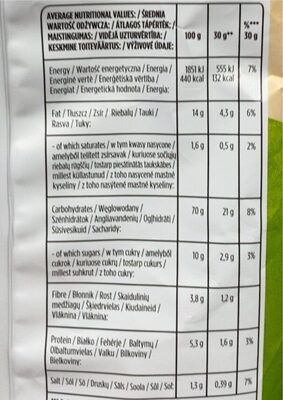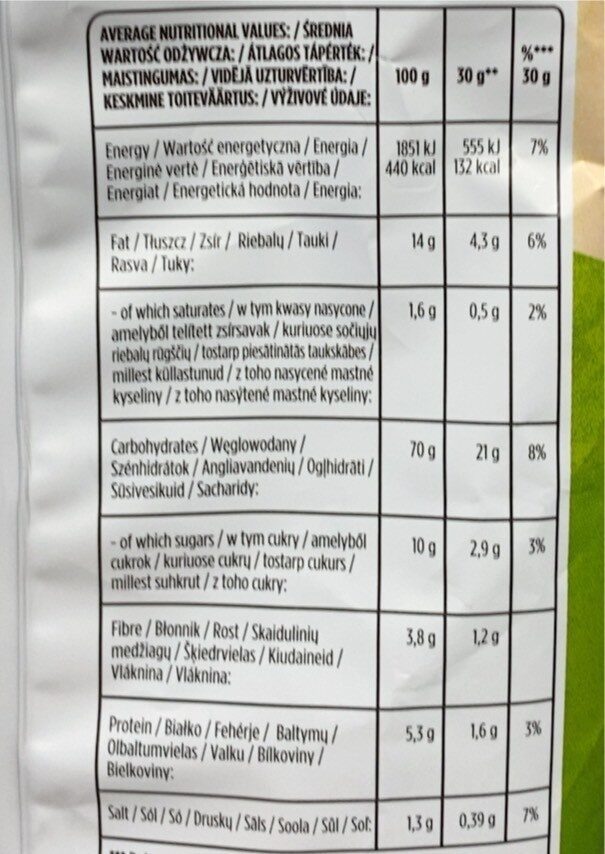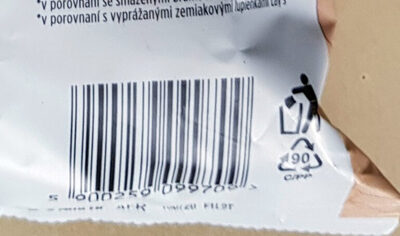Help us make food transparency the norm!
As a non-profit organization, we depend on your donations to continue informing consumers around the world about what they eat.
The food revolution starts with you!
Lay's - 125 g
Lay's - 125 g
This product page is not complete. You can help to complete it by editing it and adding more data from the photos we have, or by taking more photos using the app for Android or iPhone/iPad. Thank you!
×
Barcode: 5900259099709 (EAN / EAN-13)
Quantity: 125 g
Packaging: Plastic, Multilayer-composite, Bag, Plastic/aluminium, 90 C/PP
Brands: Lay's
Categories: Plant-based foods and beverages, Plant-based foods, Snacks, Cereals and potatoes, Salty snacks, Appetizers, Chips and fries, Crisps, Potato crisps
Manufacturing or processing places: KMV BEV CZ s.r.o., Kolbenova 510/50, Praha 9, Česká republika
Stores: Rohlík
Countries where sold: Czech Republic, Hungary, Latvia, Lithuania, Poland, Slovakia
Matching with your preferences
Health
Ingredients
-
27 ingredients
potato flakes (58%), starch, rapeseed oil, flavoring preparation [whey, salt, garlic, sugar, flavor enhancer (monosodium glutamate, disodium ribonucleotides), onions, potassium chloride, herbs (parsley, dill, mint), yogurt powder, flavors, acidity regulators (malic acid, citric acid)], sugar, wheat flour, emulsifier (soy lecithins), glucoseAllergens: Gluten, Milk, Soybeans
Food processing
-
Ultra processed foods
Elements that indicate the product is in the 4 - Ultra processed food and drink products group:
- Additive: E322 - Lecithins
- Additive: E621 - Monosodium glutamate
- Ingredient: Emulsifier
- Ingredient: Flavour enhancer
- Ingredient: Flavouring
- Ingredient: Glucose
- Ingredient: Whey
Food products are classified into 4 groups according to their degree of processing:
- Unprocessed or minimally processed foods
- Processed culinary ingredients
- Processed foods
- Ultra processed foods
The determination of the group is based on the category of the product and on the ingredients it contains.
Additives
-
E296 - Malic acid
Malic acid: Malic acid is an organic compound with the molecular formula C4H6O5. It is a dicarboxylic acid that is made by all living organisms, contributes to the pleasantly sour taste of fruits, and is used as a food additive. Malic acid has two stereoisomeric forms -L- and D-enantiomers-, though only the L-isomer exists naturally. The salts and esters of malic acid are known as malates. The malate anion is an intermediate in the citric acid cycle.Source: Wikipedia
-
E322 - Lecithins
Lecithins are natural compounds commonly used in the food industry as emulsifiers and stabilizers.
Extracted from sources like soybeans and eggs, lecithins consist of phospholipids that enhance the mixing of oil and water, ensuring smooth textures in various products like chocolates, dressings, and baked goods.
They do not present any known health risks.
-
E330 - Citric acid
Citric acid is a natural organic acid found in citrus fruits such as lemons, oranges, and limes.
It is widely used in the food industry as a flavor enhancer, acidulant, and preservative due to its tart and refreshing taste.
Citric acid is safe for consumption when used in moderation and is considered a generally recognized as safe (GRAS) food additive by regulatory agencies worldwide.
-
E621 - Monosodium glutamate
Monosodium glutamate: Monosodium glutamate -MSG, also known as sodium glutamate- is the sodium salt of glutamic acid, one of the most abundant naturally occurring non-essential amino acids. Glutamic acid is found naturally in tomatoes, grapes, cheese, mushrooms and other foods.MSG is used in the food industry as a flavor enhancer with an umami taste that intensifies the meaty, savory flavor of food, as naturally occurring glutamate does in foods such as stews and meat soups. It was first prepared in 1908 by Japanese biochemist Kikunae Ikeda, who was trying to isolate and duplicate the savory taste of kombu, an edible seaweed used as a base for many Japanese soups. MSG as a flavor enhancer balances, blends, and rounds the perception of other tastes.The U.S. Food and Drug Administration has given MSG its generally recognized as safe -GRAS- designation. A popular belief is that large doses of MSG can cause headaches and other feelings of discomfort, known as "Chinese restaurant syndrome," but double-blind tests fail to find evidence of such a reaction. The European Union classifies it as a food additive permitted in certain foods and subject to quantitative limits. MSG has the HS code 29224220 and the E number E621.Source: Wikipedia
Ingredients analysis
-
Palm oil free
No ingredients containing palm oil detected
Unrecognized ingredients: Disodium-ribonucleotidesSome ingredients could not be recognized.
We need your help!
You can help us recognize more ingredients and better analyze the list of ingredients for this product and others:
- Edit this product page to correct spelling mistakes in the ingredients list, and/or to remove ingredients in other languages and sentences that are not related to the ingredients.
- Add new entries, synonyms or translations to our multilingual lists of ingredients, ingredient processing methods, and labels.
If you would like to help, join the #ingredients channel on our Slack discussion space and/or learn about ingredients analysis on our wiki. Thank you!
-
Non-vegan
Non-vegan ingredients: Whey, Yogurt powderSome ingredients could not be recognized.
We need your help!
You can help us recognize more ingredients and better analyze the list of ingredients for this product and others:
- Edit this product page to correct spelling mistakes in the ingredients list, and/or to remove ingredients in other languages and sentences that are not related to the ingredients.
- Add new entries, synonyms or translations to our multilingual lists of ingredients, ingredient processing methods, and labels.
If you would like to help, join the #ingredients channel on our Slack discussion space and/or learn about ingredients analysis on our wiki. Thank you!
-
Vegetarian status unknown
Unrecognized ingredients: Disodium-ribonucleotidesSome ingredients could not be recognized.
We need your help!
You can help us recognize more ingredients and better analyze the list of ingredients for this product and others:
- Edit this product page to correct spelling mistakes in the ingredients list, and/or to remove ingredients in other languages and sentences that are not related to the ingredients.
- Add new entries, synonyms or translations to our multilingual lists of ingredients, ingredient processing methods, and labels.
If you would like to help, join the #ingredients channel on our Slack discussion space and/or learn about ingredients analysis on our wiki. Thank you!
-
Details of the analysis of the ingredients
We need your help!
Some ingredients could not be recognized.
We need your help!
You can help us recognize more ingredients and better analyze the list of ingredients for this product and others:
- Edit this product page to correct spelling mistakes in the ingredients list, and/or to remove ingredients in other languages and sentences that are not related to the ingredients.
- Add new entries, synonyms or translations to our multilingual lists of ingredients, ingredient processing methods, and labels.
If you would like to help, join the #ingredients channel on our Slack discussion space and/or learn about ingredients analysis on our wiki. Thank you!
: potato flakes 58%, starch, rapeseed oil, flavoring preparation (whey, salt, garlic, sugar, flavor enhancer (monosodium glutamate, disodium ribonucleotides), onions, potassium chloride, herbs (parsley, dill, mint), yogurt powder, flavors, acidity regulators (malic acid, citric acid)), sugar, wheat flour, emulsifier (soy lecithins), glucose- potato flakes -> en:potato-flakes - vegan: yes - vegetarian: yes - ciqual_food_code: 4003 - percent_min: 58 - percent: 58 - percent_max: 58
- starch -> en:starch - vegan: yes - vegetarian: yes - ciqual_proxy_food_code: 9510 - percent_min: 6 - percent_max: 42
- rapeseed oil -> en:rapeseed-oil - vegan: yes - vegetarian: yes - from_palm_oil: no - percent_min: 0 - percent_max: 33.3333333333333
- flavoring preparation -> en:flavouring-preparation - vegan: maybe - vegetarian: maybe - percent_min: 0 - percent_max: 5
- whey -> en:whey - vegan: no - vegetarian: maybe - percent_min: 0 - percent_max: 5
- salt -> en:salt - vegan: yes - vegetarian: yes - ciqual_food_code: 11058 - percent_min: 0 - percent_max: 1.3
- garlic -> en:garlic - vegan: yes - vegetarian: yes - ciqual_food_code: 11000 - percent_min: 0 - percent_max: 1.3
- sugar -> en:sugar - vegan: yes - vegetarian: yes - ciqual_proxy_food_code: 31016 - percent_min: 0 - percent_max: 1.3
- flavor enhancer -> en:flavour-enhancer - percent_min: 0 - percent_max: 1
- monosodium glutamate -> en:e621 - vegan: yes - vegetarian: yes - percent_min: 0 - percent_max: 1
- disodium ribonucleotides -> en:disodium-ribonucleotides - percent_min: 0 - percent_max: 0.5
- onions -> en:onion - vegan: yes - vegetarian: yes - ciqual_food_code: 20034 - percent_min: 0 - percent_max: 0.833333333333333
- potassium chloride -> en:e508 - vegan: yes - vegetarian: yes - percent_min: 0 - percent_max: 0.714285714285714
- herbs -> en:herb - vegan: yes - vegetarian: yes - percent_min: 0 - percent_max: 0.625
- parsley -> en:parsley - vegan: yes - vegetarian: yes - ciqual_proxy_food_code: 11014 - percent_min: 0 - percent_max: 0.625
- dill -> en:dill - vegan: yes - vegetarian: yes - ciqual_food_code: 11093 - percent_min: 0 - percent_max: 0.3125
- mint -> en:mint - vegan: yes - vegetarian: yes - ciqual_food_code: 11027 - percent_min: 0 - percent_max: 0.208333333333333
- yogurt powder -> en:yogurt-powder - vegan: no - vegetarian: yes - ciqual_proxy_food_code: 19593 - percent_min: 0 - percent_max: 0.555555555555556
- flavors -> en:flavouring - vegan: maybe - vegetarian: maybe - percent_min: 0 - percent_max: 0.5
- acidity regulators -> en:acidity-regulator - percent_min: 0 - percent_max: 0.454545454545455
- malic acid -> en:e296 - vegan: yes - vegetarian: yes - percent_min: 0 - percent_max: 0.454545454545455
- citric acid -> en:e330 - vegan: yes - vegetarian: yes - percent_min: 0 - percent_max: 0.227272727272727
- sugar -> en:sugar - vegan: yes - vegetarian: yes - ciqual_proxy_food_code: 31016 - percent_min: 0 - percent_max: 5
- wheat flour -> en:wheat-flour - vegan: yes - vegetarian: yes - ciqual_proxy_food_code: 9410 - percent_min: 0 - percent_max: 5
- emulsifier -> en:emulsifier - percent_min: 0 - percent_max: 5
- soy lecithins -> en:soya-lecithin - vegan: yes - vegetarian: yes - ciqual_food_code: 42200 - percent_min: 0 - percent_max: 5
- glucose -> en:glucose - vegan: yes - vegetarian: yes - ciqual_proxy_food_code: 31016 - percent_min: 0 - percent_max: 5
Nutrition
-
Average nutritional quality
This product is not considered a beverage for the calculation of the Nutri-Score.
Positive points: 4
- Proteins: 3 / 5 (value: 5.3, rounded value: 5.3)
- Fiber: 4 / 5 (value: 3.8, rounded value: 3.8)
- Fruits, vegetables, nuts, and colza/walnut/olive oils: 0 / 5 (value: 0, rounded value: 0)
Negative points: 13
- Energy: 5 / 10 (value: 1851, rounded value: 1851)
- Sugars: 2 / 10 (value: 10, rounded value: 10)
- Saturated fat: 1 / 10 (value: 1.6, rounded value: 1.6)
- Sodium: 5 / 10 (value: 520, rounded value: 520)
The points for proteins are not counted because the negative points are greater or equal to 11.
Nutritional score: (13 - 4)
Nutri-Score:
-
Nutrient levels
-
Fat in moderate quantity (14%)
What you need to know- A high consumption of fat, especially saturated fats, can raise cholesterol, which increases the risk of heart diseases.
Recommendation: Limit the consumption of fat and saturated fat- Choose products with lower fat and saturated fat content.
-
Saturated fat in moderate quantity (1.6%)
What you need to know- A high consumption of fat, especially saturated fats, can raise cholesterol, which increases the risk of heart diseases.
Recommendation: Limit the consumption of fat and saturated fat- Choose products with lower fat and saturated fat content.
-
Sugars in moderate quantity (10%)
What you need to know- A high consumption of sugar can cause weight gain and tooth decay. It also augments the risk of type 2 diabetes and cardio-vascular diseases.
Recommendation: Limit the consumption of sugar and sugary drinks- Sugary drinks (such as sodas, fruit beverages, and fruit juices and nectars) should be limited as much as possible (no more than 1 glass a day).
- Choose products with lower sugar content and reduce the consumption of products with added sugars.
-
Salt in moderate quantity (1.3%)
What you need to know- A high consumption of salt (or sodium) can cause raised blood pressure, which can increase the risk of heart disease and stroke.
- Many people who have high blood pressure do not know it, as there are often no symptoms.
- Most people consume too much salt (on average 9 to 12 grams per day), around twice the recommended maximum level of intake.
Recommendation: Limit the consumption of salt and salted food- Reduce the quantity of salt used when cooking, and don't salt again at the table.
- Limit the consumption of salty snacks and choose products with lower salt content.
-
-
Nutrition facts
Nutrition facts As sold
for 100 g / 100 mlAs sold
per serving (30 g)Compared to: Potato crisps Energy 1,851 kj
(440 kcal)555 kj
(132 kcal)-15% Fat 14 g 4.2 g -55% Saturated fat 1.6 g 0.48 g -57% Carbohydrates 70 g 21 g +31% Sugars 10 g 3 g +408% Fiber 3.8 g 1.14 g -8% Proteins 5.3 g 1.59 g -13% Salt 1.3 g 0.39 g -4% Fruits‚ vegetables‚ nuts and rapeseed‚ walnut and olive oils (estimate from ingredients list analysis) 9.356 % 9.356 %
Environment
-
Eco-Score B - Low environmental impact
⚠ ️Select a country in order to include the full impact of transportation.The Eco-Score is an experimental score that summarizes the environmental impacts of food products.→ The Eco-Score was initially developped for France and it is being extended to other European countries. The Eco-Score formula is subject to change as it is regularly improved to make it more precise and better suited to each country.Life cycle analysis
-
Average impact of products of the same category: A (Score: 87/100)
Category: Potato crisps
Category: Potato crisps
- PEF environmental score: 0.22 (the lower the score, the lower the impact)
- including impact on climate change: 1.54 kg CO2 eq/kg of product
Stage Impact Agriculture
62.8 %Processing
17.3 %Packaging
10.6 %Transportation
7.1 %Distribution
2.2 %Consumption
0.0 %
Bonuses and maluses
-
Missing origins of ingredients information
Malus: -5
⚠ ️ The origins of the ingredients of this product are not indicated.
If they are indicated on the packaging, you can modify the product sheet and add them.
If you are the manufacturer of this product, you can send us the information with our free platform for producers.
-
Packaging with a high impact
Malus: -15
Shape Material Recycling Impact 1 Bag PP 5 - Polypropylene High Unknown 90 C/PP High ⚠ ️ The information about the packaging of this product is not sufficiently precise (exact shapes and materials of all components of the packaging).⚠ ️ For a more precise calculation of the Eco-Score, you can modify the product page and add them.
If you are the manufacturer of this product, you can send us the information with our free platform for producers.
Eco-Score for this product
-
Impact for this product: B (Score: 67/100)
Product: Lay's - 125 g
Life cycle analysis score: 87
Sum of bonuses and maluses: -20
Final score: 67/100
-
Carbon footprint
-
Equal to driving 0.8 km in a petrol car
154 g CO² per 100g of product
The carbon emission figure comes from ADEME's Agribalyse database, for the category: Potato crisps (Source: ADEME Agribalyse Database)
Stage Impact Agriculture
53.5 %Processing
15.0 %Packaging
18.2 %Transportation
11.9 %Distribution
1.3 %Consumption
0.0 %
Packaging
-
Packaging with a high impact
-
Packaging parts
1 x Bag (PP 5 - Polypropylene)
(90 C/PP)
-
Packaging materials
Material % Packaging weight Packaging weight per 100 g of product Plastic
-
Transportation
-
Origins of ingredients
Missing origins of ingredients information
⚠ ️ The origins of the ingredients of this product are not indicated.
If they are indicated on the packaging, you can modify the product sheet and add them.
If you are the manufacturer of this product, you can send us the information with our free platform for producers.Add the origins of ingredients for this product Add the origins of ingredients for this product
Report a problem
-
Incomplete or incorrect information?
Category, labels, ingredients, allergens, nutritional information, photos etc.
If the information does not match the information on the packaging, please complete or correct it. Open Food Facts is a collaborative database, and every contribution is useful for all.
Data sources
Product added on by openfoodfacts-contributors
Last edit of product page on by inf.
Product page also edited by arc2, bathorypeter, danis1597, kiliweb, matislime, packbot, sierigh, yuka.sY2b0xO6T85zoF3NwEKvlmlDWMrCixOYZwzgs2yHmO-oD8S0bdtO7KHQMKg.







